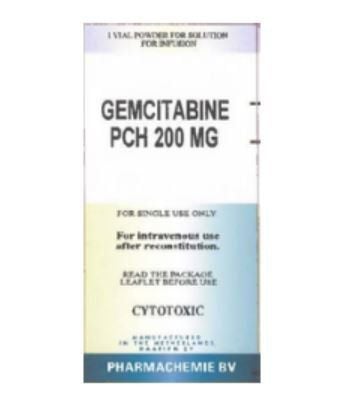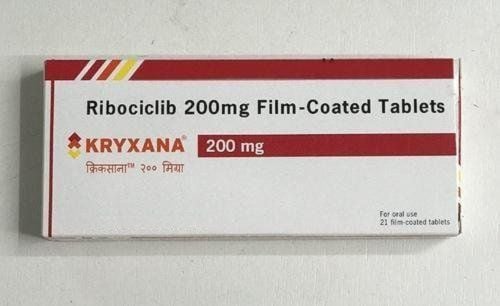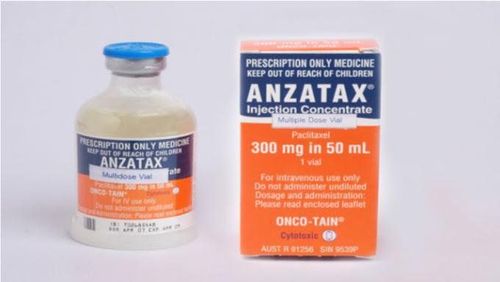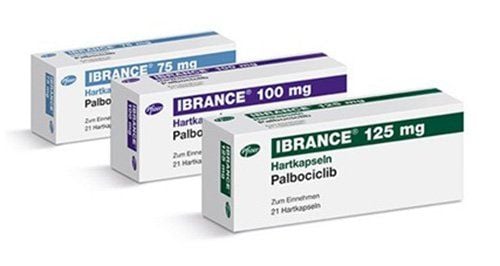This is an automatically translated article.
Article written by Pharmacist Ly Anh Thu - Clinical Pharmacist, Faculty of Pharmacy - Vinmec Central Park International Hospital
Faslodex is indicated for the treatment of postmenopausal women with estrogen receptor-positive locally advanced or metastatic breast cancer.
1. Dosage form and content
Solution for Injection One syringe contains 250mg of Fulvestrant in 5ml of solution.
2. Mechanism
Fulvestrant is a competitive estrogen receptor (ER) antagonist with affinity comparable to estradiol. Fulvestrant blocks the vegetative action of estrogens without a partial (estrogen-like) agonist action. The mechanism of action is related to the down-regulation of ER-protein levels.
3. Indications and contraindications for drug use
3.1 Indications Faslodex is indicated for the treatment of postmenopausal women with estrogen receptor positive locally advanced or metastatic breast cancer.
Previous endocrine therapy-nave Recurrence during or after adjuvant anti-estrogen therapy, or progression during anti-estrogen therapy 3.2 Contraindications Hypersensitivity to the active substance or to any of the excipients. Pregnant and lactating women. Severe liver failure.
4. Dosage – how to use
4.1 Dosage Adults (including the elderly) Recommended dose:
Start 500mg/time on the 1st, 15th and 29th days of the month.
Maintenance dose: 500mg/time every 28 days.

Người bệnh cần sử dụng thuốc đúng liều được bác sĩ chỉ định
Special populations Renal impairment No dose adjustment is required for patients with mild to moderate renal impairment (creatinine clearance ≥ 30ml/min). Caution should be exercised in patients with severe renal impairment (creatinine clearance ≤30 ml/min).
Hepatic impairment No dose adjustment is required for patients with mild to moderate hepatic impairment. However, caution should still be exercised when using Faslodex in these patients.
4.2 How to use Faslodex is indicated with 2 continuous injections of 5ml, slow intramuscular (1-2 minutes/injection), 1 injection in each buttock (buttock muscle).
5. Special note and caution when using
Use Faslodex with caution in patients with mild to moderate hepatic impairment. Faslodex should be used with caution in patients with severe renal impairment (creatinine clearance < 30 ml/min). Because the drug is administered intramuscularly, caution should be exercised in patients with a predisposition to bleeding, thrombocytopenia, or on anticoagulant therapy. Thromboembolism has been frequently reported in women with advanced breast cancer and has also been reported in clinical studies with Faslodex. This should be considered when prescribing Faslodex to patients at risk. Injection site reactions including sciatica, neuropathic pain, neuropathic pain, and peripheral neuropathy have been reported with Faslodex injection. Caution should be exercised when injecting Faslodex into the dorsogluteal site due to its proximity to the inferior sciatic nerve. There are no long-term studies on the effects of fulvestrant on bone. Due to the mechanism of action of fulvestrant, there is a risk of osteoporosis when used. Children: Faslodex is not recommended for use in children and adolescents because safety and efficacy in this patient population have not been established. Patients of childbearing potential should use effective methods of contraception during treatment.
Pregnant women Faslodex is contraindicated for use in pregnant women. If pregnancy occurs while taking Faslodex, the patient should be informed of the potential hazard to the fetus and the risk of miscarriage.
Lactating women Breastfeeding should be discontinued during treatment with Faslodex and 1 year after the last dose. Use during breastfeeding is contraindicated due to the risk of serious adverse events associated with fulvestrant in breastfed infants.
Fertility Based on animal studies and mechanism of action, fulvestrant may cause fetal harm if taken during pregnancy.
For women of childbearing potential, a pregnancy test should be performed within 7 days before starting fulvestrant and effective contraception should be used while taking fulvestrant and for 1 year after the last dose.
Effects on ability to drive and use machines Faslodex has no or negligible influence on the ability to drive and use machines. However, because the drug can be debilitating, patients with these side effects should be cautious.
Patients with heavy alcoholism should inform their doctor before using the drug

Thuốc có khả năng ảnh hưởng tới khả năng lái xe và vận hành máy móc
6. Drug interactions with other drugs and other types of interactions
Does not interact with CYP3A4 inhibitors or inducers such as Midazolam or Rifampicin.
Interaction with drugs: Methotrexate, Tranexamic acid, Tamoxifen.
Especially tell the doctor if the patient is taking anticoagulants (medicines to prevent blood clots) such as: Warfarin, Aspirin.
7. Unwanted side effects
Very common side effects:
Hypersensitivity reactions including swelling of the face, lips, tongue and throat Nausea (10% to 28%) Increased liver enzymes (49%) Rash (6% to 7%) Pain joint and musculoskeletal pain Asthenia (8% to 32%) Injection site reactions (12%) Common side effects:
Anorexia (6%) Headache (8% to 15%) Vomiting (6%) up to 15%) Diarrhea (6% to 25%) Increased bilirubin (>15%) Back pain (8% to 17%) Peripheral neuralgia, sciatica: sudden weakness, paralysis, itching or loss of movement in the legs, especially the upper body.

Một số người bệnh có thể gặp tình trạng chán ăn khi dùng thuốc
Uncommon side effects:
Vaginal bleeding and candida infection Bruising and bleeding at the injection site Increased liver enzymes (gamma-GT) Hepatitis Liver failure Numbness, itching and pain
Please dial HOTLINE for more information or register for an appointment HERE. Download MyVinmec app to make appointments faster and to manage your bookings easily.













